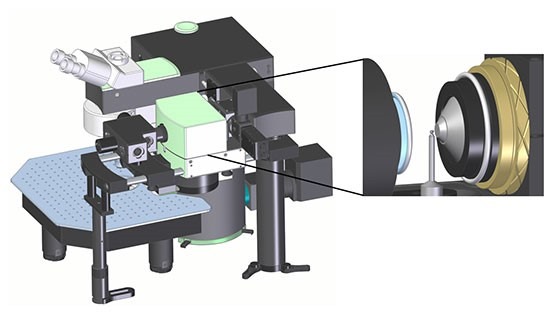Nov 13 2014
LaVision BioTec, developers of advanced microscopy solutions for the life sciences, announce they will introduce new products for their UltraMicroscope and TriM Scope microscopy products at the 2014 annual meeting of the Society for Neuroscience (SfN).
LaVision BioTec will announce the release of several ground-breaking new products at the 2014 meeting of the Society for Neuroscience to be held in Washington DC, November 15-19. Delegates are invited to visit LaVision on Booth #817 to meet the product group and learn about the latest innovations from the company.
TriM Scope II is an intravital 2-photon microscope. Three new developments are announced at the meeting. First is a 4x Cloud Scanner. This is a beam multiplexer for 2-photon laser scanning microscopes to generate a 4 foci line pattern in the specimen. In microscopy, pixel size often exceeds the size of the focal spot of the excitation beam. This means, higher fluorescence intensities can be acquired without losing resolution if the whole area of a pixel is excited. LaVision BioTec's 4x Cloud Scanner separates the single excitation beam both spatially and temporarily, improving overall system performance.

A schematic of the LaVison BioTec horizontal 2-photon microscope.
The Horizontal 2-Photon Microscope is a new add-on for TriMScope II microscopes that allows sample rotation by 360°. The advantage of sample rotation is that imaging from the side into the sample and rotation of the sample by 180° doubles the penetration depth. In addition, the Horizontal 2-Photon Microscope enables a good resolution in all dimensions and the possibility of tomographical reconstruction.
The 2-Photon Laser-Scanning Rotational Microendoscope has a long tip (<18mm) with an objective lens that focusses excitation light into the back focal plane of a thin rod lens. This in turn focusses the light into the sample and allows different imaging modes: 3D volume acquisition and 360° panorama view. By placing the microendoscope tip in the sample, it is possible to image deeper into the tissue. This means it overcomes the limitation of the penetration depth in standard in vivo imaging and enlarges the imaging volume by one order of magnitude. Furthermore, the whole microendoscope can be moved up and down allowing the additional recording of spiral panorama datasets.
Lastly, LaVision BioTec announces multi Immersion objectives for the modular UltraMicroscope II HR system. They have been designed for different refractive indices ranging from water (RI=1.33) to benzyl ether (RI=1.56). These LVMI-Fluor objectives can operate in both organic solvents and aqueous buffers. The UltraMicroscope II HR can be used with diverse clearing protocols to allow in vivo imaging to cleared tissue imaging. The modular UltraMicroscope II HR system with its flexible design offers the possibility to also operate the microscope with standard dipping objectives. For details about all of LaVision BioTec's products and applications, please contact LaVision BioTec on +49 (0)5219151390, visit the web site: www.lavisionbiotec.com.